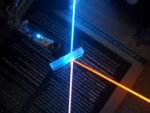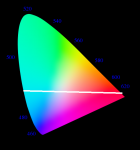- Joined
- Mar 22, 2015
- Messages
- 561
- Points
- 43
I understand that blue and yellow LED's mix together to make white, so does it stand to reason that a cyan wavelength and red wavelength combine to make white? I could see pass blue+green reflect red dichroic mirrors being used along with red and the newer cyan diodes to make relatively simple white lasers. But, they wouldn't be full color would they? could you make yellow? could you make green? blue is obviously out of the question.
Last edited:








